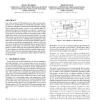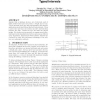EDBT
2016
ACM
8 years 8 months ago
2016
ACM
Next generation sequencing (NGS) and the recent development of efficient algorithms for genomic analysis are contributing to the understanding of human genetic variation and thus ...
EDBT
2016
ACM
8 years 8 months ago
2016
ACM
In this paper we present our work in progress on revisiting traditional DBMS mechanisms to manage space on native Flash and how it is administered by the DBA. Our observations and...
EDBT
2016
ACM
8 years 8 months ago
2016
ACM
This paper studies how to enforce differential privacy by using the randomized response in the data collection scenario. Given a client’s value, the randomized algorithm execute...
EDBT
2016
ACM
8 years 8 months ago
2016
ACM
Most emerging applications, especially in science domains, maintain databases that are rich in metadata and annotation information, e.g., auxiliary exchanged comments, related art...
EDBT
2016
ACM
8 years 8 months ago
2016
ACM
Due to the increase of GPS enabled devices and a lot of locationbased services, spatial objects are continuously generated. This paper addresses a problem of monitoring MaxRS (Max...
EDBT
2016
ACM
8 years 8 months ago
2016
ACM
The dynamic nature of the data on the Web gives rise to a multitude of problems related to the description and analysis of the evolution of such data. Traditional approaches for i...
EDBT
2016
ACM
8 years 8 months ago
2016
ACM
Keyword-search engines (e.g. Web-search) usually can be outperformed by a specialized system optimized for a specific domain, type of data, or queries [8, 2, 12, 5, 11, 9]. For e...
EDBT
2016
ACM
8 years 8 months ago
2016
ACM
In this work, we address the problem of contextual recommendations by exploiting the concept of fault-tolerant subspace clustering. Specifically, we pre-partition users that have...
EDBT
2016
ACM
8 years 8 months ago
2016
ACM
Assume that a database stores a set of intervals, each of which defines start and end points, a weight and a type. Typed intervals enrich the data representation and support appl...
EDBT
2016
ACM
8 years 8 months ago
2016
ACM
Over the last few years we witness an explosion on the development of data management solutions for big data applications. To this direction NoSQL databases provide new opportunit...




